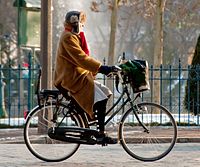
Photo from wikipedia
Many benefits of physical activity (PA) are observed with weekly average volumes of 150–300 min at moderate intensity. Public parks may be an attraction for many people living in the… Click to show full abstract
Many benefits of physical activity (PA) are observed with weekly average volumes of 150–300 min at moderate intensity. Public parks may be an attraction for many people living in the city and could help to achieve the recommended dose of PA. The present study aims to understand the motivation that drives people to a park and evaluate the amount of PA practiced by park-goers. A questionnaire was anonymously administered to 383 voluntary visitors to the Arcoveggio park (Bologna), aged 18–70 years. Sixty-one percent of participants practiced outdoor PA. Differences in park use between sexes and age groups were found. PA was higher in men than in women and in the 18–30 age group than in other age groups. Most participants travelled to the park in an active way (86.4%), resulting in easier attainment of the recommended amount of PA (64.5%). The main motivations for using the park were related to relaxation, performing PA, or both. According to a multiple regression model, the time per week spent at the park, the method of getting there, and the kind of PA were significant explanatory variables of the amount of PA practiced. In particular, the highest number of minutes of PA was achieved by those who travelled to the park by running, while those using vehicles presented the lowest number. All initiatives to promote active commuting and activities in the urban park represent an important strategy to improve health, supporting adults to lead an active lifestyle.
Journal Title: International Journal of Environmental Research and Public Health
Year Published: 2022
Link to full text (if available)
Share on Social Media: Sign Up to like & get
recommendations!